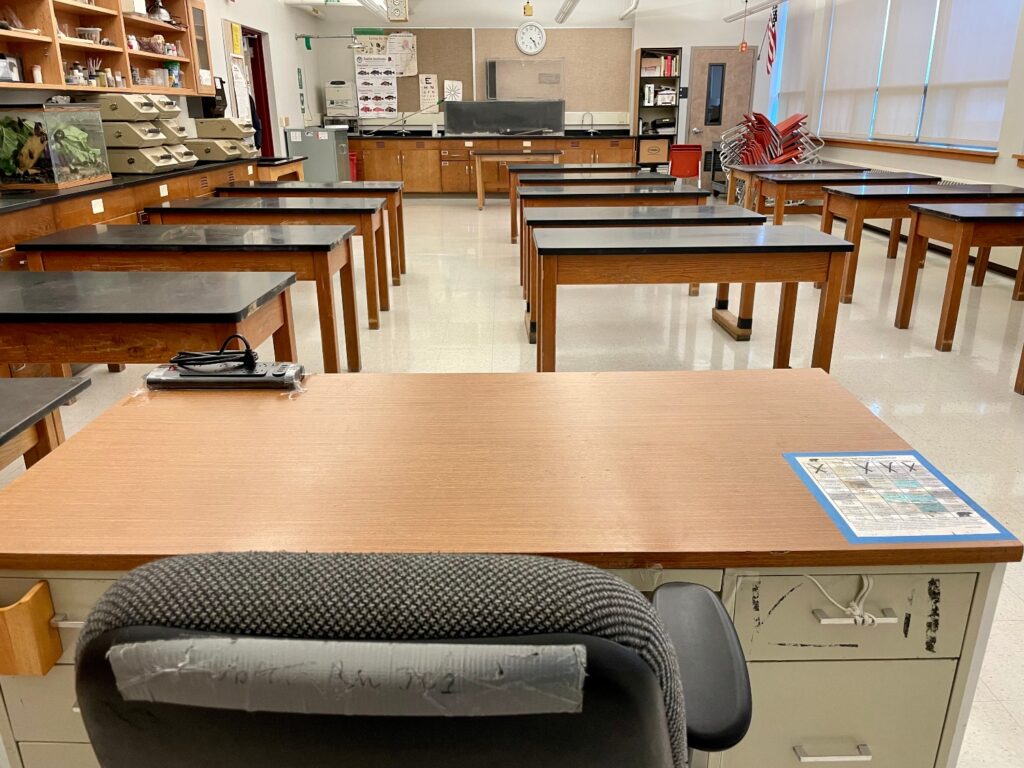An empty classroom at Juneau-Douglas High School: Yadaa.at Kalé in Juneau, Alaska, on July 20, 2022. (Photo by Lisa Phu/Alaska Beacon)
Twenty-three Alaska Native languages have been recognized alongside English as official Alaska state languages for a decade, but until this month there was no measure by which its schools could gauge reading competency in them.
A group of Alaska Native educators developed reading standards for Alaska Native languages and presented them to the Alaska Board of Education and Early Development on Oct. 9. It is now up to the board and Gov. Mike Dunleavy to decide whether or not to implement the new standards, which would allow Alaska Native languages to satisfy the state’s reading requirements.
The change would be a step towards parity for Alaska Native languages with the English language in the state’s education system.
Sealaska Heritage Institute, the nonprofit arm of the Alaska Native Corporation Sealaska, contracted with TIDES Education Associates to develop the standards for the state.
Nancy Douglas, an educator and curriculum specialist with TIDES, said the standards honor Alaska Native ways of knowing within the state’s school system.
“The goal was to make sure the standards honored our worldview, and that it’s holding up the knowledge students come to school with and learn through,” she said.
To this end, the reading standards emphasize cultural literacy and place-based knowledge through metrics that reflect how Alaska Native knowledge has been transmitted through oral narrative. Students will be asked to demonstrate the skills of listening, thinking, speaking and understanding in addition to reading text if the standards are adopted.
The standards are a metric by which to gauge literacy in nearly two dozen distinct languages.
Jamie Shanley, an early childhood educator and assistant director of education at SHI, said the reading standards are meaningful in an historical context because of the state’s recent history of forced assimilation in educational settings.
“Schools have worked to strip Indigenous people of their cultures and languages, and so we have to use schools to be able to support bringing that back to children and families,” she said.
Sealaska Heritage Institute’s education director, Kristy Ford, said the standards are unique, and they broaden the lens of what can be described as reading. She said the scarcity of expertise means the state should prioritize supporting those educators and their materials.
“In Alaska, these languages are spoken on this land, in those particular communities, and no place else in the world,” she said. “There’s a handful of people that have the skills and the abilities to develop instructional materials to teach the language.”
Shgen George, one of that handful of people as a Tlingit educator and curriculum specialist with TIDES Education Associates, said developing the standards was a challenge because it involved translating an Alaska Native worldview in which teaching is very integrated into one where reading is its own discrete skill.
“Asking us to kind of take everything apart and parcel it out and just pull out reading…I felt like it was counterintuitive to our worldview,” she said.
“I think it’s just another example of Indigenous genius, adapting and survival, really, to hold our children up.”
GET THE MORNING HEADLINES.

